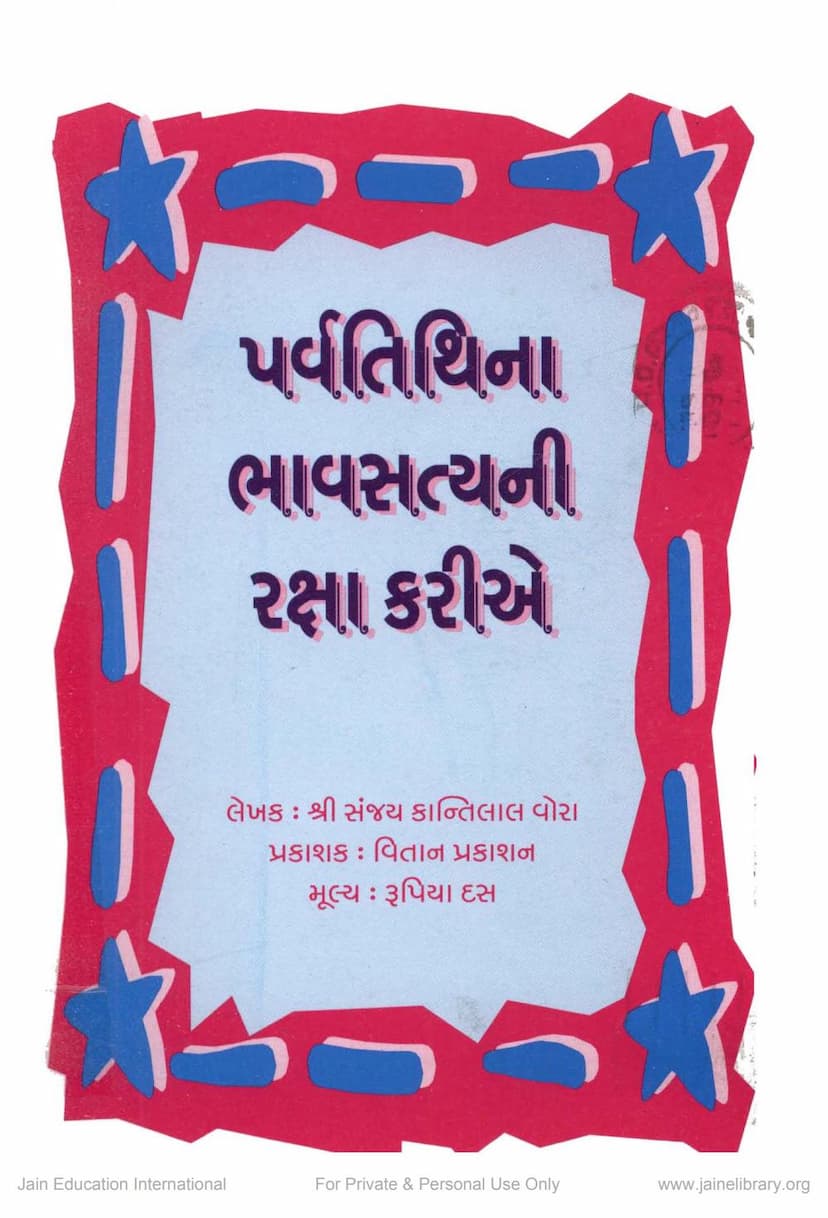Parvatithina Bhavsatyani Raksha Karie
Added to library: September 2, 2025

Summary
This document is a summary of the book "Parvatithina Bhavsatyani Raksha Karie" by Sanjay Kantilal Vora, published by Vitan Prakashan, Thane. The book addresses the ongoing debate within the Shwetambar Murtipujak Jain Tapagacch Sangh regarding the correct observance of Parva Tithi (auspicious dates), particularly focusing on the dispute surrounding the date of Samvatsari.
Here's a breakdown of the key points and arguments presented in the text:
1. The Core Problem: Dispute over Parva Tithi
- The book highlights a long-standing issue within the Tapagacch community regarding the determination of auspicious dates, which has led to differing opinions and practices.
- The immediate catalyst for this book is the impending Samvatsari celebration in Vikram Samvat 2061, where a division is expected, with one group observing it on September 7th and another on September 8th, 2005.
- The author expresses concern that this disagreement could lead to disharmony and the spread of ill will within the community.
2. The Central Argument: Defense of Audayik Tithi (Uday-based Date)
- The author strongly advocates for adhering to the audayik tithi (the tithi that prevails at sunrise) as the correct way to observe Parva Tithi.
- This is presented as the true "truth" (bhavsatya) of the festival, contrasting with what the author considers a deviation from scriptural mandates.
3. Critique of a Specific Propagated View:
- The book specifically addresses a statement made in a booklet by Acharya Vijay Abhayashekhar Suriji, which suggests that: "There is no need to insist on audayik tithi for the worship of Parva Tithi. Worship can be done on another tithi by making audayik tithi secondary."
- The author vehemently disagrees with this statement, citing scriptural pronouncements by ancient Jain scholars (like Acharya Umashwati) that clearly state that adhering to audayik tithi is paramount.
- Violating this principle, according to the author, leads to four grave sins: disobedience to divine command, anarchy, false belief (mithyatva), and violation of religious principles (viradhana).
4. The Distinction Between Dravyasatya and Bhavsatya
- The author discusses the concepts of dravyasatya (material truth, factual truth) and bhavsatya (essential truth, truth that is beneficial).
- While acknowledging that sometimes bhavsatya might take precedence over dravyasatya (as illustrated by the example of a Mahatma misleading a hunter to save a deer), the author argues that this principle is being misused and misapplied in the Parva Tithi dispute.
- The author contends that in matters of Parva Tithi, the audayik tithi is the dravyasatya, and adhering to it is the true bhavsatya. To abandon audayik tithi in favor of convenience or perceived unity is a misinterpretation of the concept.
5. Historical Context of the Samvatsari Date:
- The book traces the history of the Samvatsari date, noting that it was originally celebrated on Bhadrava Sud Pancham.
- It explains that Acharya Kalik Suri changed the date to Bhadrava Sud Chaturthi (the fourth lunar day), and this has been the tradition for the Tapagacch.
- The author notes that other sects (like Sthanakavasis) and some branches within the Shwetambar tradition follow the original Pancham date.
6. Analysis of the Calendar Dispute (Tithi Bhed)
- The author meticulously analyzes the Janmabhoomi Panchang (almanac) for Vikram Samvat 2061, which is accepted by the Tapagacch.
- Based on the almanac, the author demonstrates that Bhadrava Sud Chaturthi falls on Wednesday, September 7th, 2005, making it the audayik tithi.
- The book criticizes the majority faction within the Tapagacch for choosing to celebrate Samvatsari on Thursday, September 8th, by manipulating the calendar (e.g., by considering the first Pancham as Chaturthi or by shifting dates).
- The author argues that this manipulation is an attempt to avoid a perceived conflict with the Pancham date if it were to occur simultaneously, but this is seen as a departure from scriptural adherence.
7. The Flawed Reasoning of the Opposing View:
- The author refutes the examples provided by Acharya Vijay Abhayashekhar Suriji, arguing that they do not support the idea of abandoning audayik tithi.
- For instance, the example of the eighth lunar day (Ashtami) being observed on the seventh lunar day (Saptami) when Ashtami is absent (kshaya) is presented as an exception (apavada) that applies only when the audayik tithi is truly absent, not when it is present.
- The example of Diwali is similarly dissected, stating that while there are exceptions for the observance of Lord Mahavir's moksha kalyanak, these are specific scripturally ordained exceptions and cannot be applied universally to other festivals like Samvatsari.
8. The Importance of Jinaagnya (Divine Command) over Majority Opinion:
- The author emphasizes that true unity within the Shri Sangh (Jain community) should be based on scriptural principles and not on mere majority opinion or compromise that violates these principles.
- The author argues that even if a large number of learned monks (gitarth) agree on a practice, it is only considered a divine command (jinaagnya) if it aligns with the scriptures.
- The author criticizes the idea of sacrificing scriptural truth for the sake of apparent unity, stating that such unity is superficial and ultimately detrimental.
9. Proposed Solutions and a Call for Unity:
- The author suggests that the Sangh should strive for unity based on adherence to audayik tithi and scriptural principles.
- One proposed solution involves using specific almanacs where the dates align favorably, or even developing localized almanacs that respect the audayik tithi for different regions.
- Ultimately, the author urges the community to prioritize scriptural truth and unity based on that truth, rather than compromising principles for the sake of perceived harmony.
In essence, the book "Parvatithina Bhavsatyani Raksha Karie" is a strong defense of the principle of observing Parva Tithi based on the audayik tithi as prescribed by Jain scriptures. It critically analyzes arguments that suggest otherwise, labels them as misinterpretations or deviations from true Jain principles, and calls for a return to scriptural adherence to maintain harmony and spiritual integrity within the Jain community.